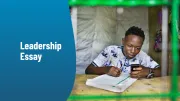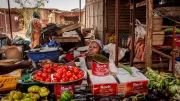Recent Blogs
Blog
Financial Inclusion 2.0: Generating New Evidence to Maximize Impact
Despite extensive research, the financial inclusion sector still lacks a clear understanding of what works, when, and for whom. Financial services' impact varies widely, highlighting the need for new research and more nuanced insights.Blog
In a Post-Pandemic World, How Healthy Are MFIs?
CGAP analysis with MFR of MFIs post-COVID suggests that there seems to be a cluster of institutions still experiencing high credit risk, and unfortunately, the smallest institutions seem to be facing the biggest problems.Blog
Are Climate-Related Financial Sector Policies Inclusive for All?
Climate-driven financial policies could inadvertently end up undermining financial inclusion efforts. Authorities and funders must understand the pathways through which risks could occur and the opportunities for supporting green finance effectively.Blog
Financial Inclusion and Stability: A Balancing Act
Understanding the relationship between financial inclusion and stability is imperative for policymakers to advance both these goals and respond to shocks that threaten financial stability in ways that protect inclusion.Blog
Digitizing G2P Payments: Lessons from Indonesia
Indonesia's digitization transformation for G2P payments showcases what can be achieved when strong government commitment and collaboration are combined with advanced technologies.Blog
Financially Including Young Women: Gains for a Generation
The final blog in our series with the Bill and Melinda Gates Foundation spotlights what CGAP and BMGF have learned about the dynamics of young women’s financial exclusion, and new initiatives to tackle the gender gap at its source in young adulthood.Blog
Good News for Young Women’s Financial Inclusion in East Africa
Young women in East Africa are demanding and using financial services earlier and faster than a decade ago, according to Bill and Melinda Gates Foundation analysis of Findex 2021 and 2011 data. The second blog in our series unpacks these findings.Blog
Open Finance Can Reduce Financial Inclusion Gaps: Here’s How
Open finance can be a transformational enabler to unleash the power of data to increase financial inclusion. Data-driven strategies and open finance ecosystems can revolutionize access to financial services, especially for underserved communities.Blog
How Do Financial Systems Support Climate Resilience?
The third in our three-part blog series with Decodis and MSC discusses our finding that different climate events, and different phases of those events, drive different needs for financial services.Blog
Supply-Side Gender Data is a Game Changer for Financial Inclusion
Gender-disaggregated data is the cornerstone for designing strategies and interventions that not only help increase women’s use of financial services to be more resilient and prosperous but also empower them to be stronger market players.Blog
Adapting to or Just Muddling Through Climate Change?
The second blog in our series with Decodis and MSC explores our research finding that many poor households are just muddling through climate events rather than strategically adapting to long-term climate change in ways that enhance their resilience.Blog
How Can Insurance Help Build a Green, Resilient & Inclusive Future?
To ensure those living in poverty benefit from emerging models in insurance, we need to focus beyond traditional risk transfer and look at broader risk management. This blog outlines three priorities for driving systems change in inclusive insurance.Blog
Facing Climate Events in Nigeria, Farmers Left With Scarce Options
Based on interviews with hundreds of farmers in Nigeria, we unpack how households use financial services in responding to climate events.Blog
Decoding Financial Inclusion Gaps Between Young Men and Women
A recent CGAP study revealed a gender gap in financial service adoption among youth in low-income countries. Here, we analyze Findex 2021 data to better understand the factors driving these disparities.Blog
How Fostering Competition in LAC Can Revolutionize Financial Inclusion
Governments in LAC recognize the importance of advancing digital financial inclusion and fostering competition among financial service providers to improve choices and quality and lower costs for all consumers - including those living in poverty.Blog
Top Blog Posts of 2023
Check out the top CGAP blogs from 2023.Blog
How Can Regulators Enable Last-Mile Agent Networks?
Extensive and inclusive cash-in/cash-out (CICO) agent networks are key to ensuring DFS access in rural areas. Regulators play an essential role here by enabling DFS providers to innovate agent network models that are sustainable in rural areas.Blog
Cash vs. Digital? Unleashing the Power of DFS through Agent Networks
The rise of DFS has sparked debate on cash's future in developing economies. But, despite increasing adoption of DFS, cash prevails in most global economies, emphasizing agent networks' crucial role as enablers rather than disruptors.Blog
Lessons From 4 Examples on the Leading Edge of Climate-Focused G2P
All G2P programs contribute to climate adaptation to some extent, with examples in India, Ethiopia, Kenya, and the Philippines showing us how specific program design features can support greater climate adaptation for recipients and their households.Blog




















